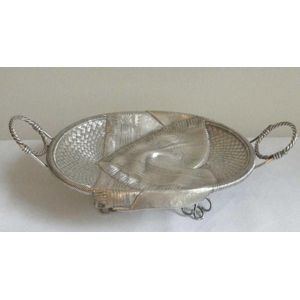Russian Silver Trompe l'Oeil Basket
You must be a subscriber, and be logged in to view price and dealer details.
Subscribe Now to view actual auction price for this item
When you subscribe, you have the option of setting the currency in which to display prices to $Au, $US, $NZ or Stg.
- Trompe L'oeil - Literally translated from the French, trompe l'oeil means "to deceive or trick the eye" and describes works whose subjects are presented so realistically that the viewer of the artwork or object believe they are looking at a three-dimensional object.
- Bread Basket - Bread baskets were commonly used from the 17th to the 19th centuries in Europe and America as a serving piece at formal meals. In the early 17th century, bread baskets were made of wood, pewter and later silver as it was an expensive and prestigious material and demonstrated off the host?s wealth and status.
These bread baskets were usually oval or circular in shape, and were typically decorated with intricate engravings, embossing, and other decorative details. Some were plain and simple, while others were quite ornate, featuring raised scrollwork, beading, or other decorative motifs. Those made in the early 17th century tend to have two handles but surviving examples are rare. From the mid 1770s they usually have a central swing handle. The handles were typically ornate and often curved or scrolled. The shape and size of these baskets varies; some are large, meant to hold multiple loaves, others are more compact and meant for one loaf. By the 18th century, most bread baskets were made of silver. - Damask - Damask is a type of fabric that is characterized by its glossy finish, smooth texture, and intricate designs. The fabric is typically made from a combination of silk and other natural fibers, such as cotton or linen, and is often used to make clothing, upholstery, and other decorative items.
The origins of damask fabric can be traced back to ancient Rome and the Byzantine Empire, where it was used to make clothing and other textiles.
The fabric is made by weaving the fabric in such a way that the design is created by the different reflectivity of the warp and weft threads, rather than by the use of dyed threads. The designs are often floral or geometric patterns and can be very intricate. The effect is a reversible fabric, with a glossy pattern on one side and a matte pattern on the other.
This item has been included into following indexes:
-
Russian
- jewellery 23
- precious objects 327
- silver items 297
- trompe l'oeil objects 10
Visually similar items

A Rhoda Wagner style brooch, set with rose Quartz in sterling silver. Length 3 cm. Weight 5.5g

A silver sovereign case, traditional round form with the exterior decorated in a snakeskin effect, marks rubbed.

George III single handled lemon strainer with elaborately designed handle attached to a circular, gadrooned rimmed and pierced bottom strainer section, marks gothic date letter, maker 'H/R/P' over B, possibly S Herbert & Co, height 3 cm, width 18 cm diamet

A full hunter silver & enamel pocket watch; guilloche white dial with Roman numerals, subsidiary seconds on a 17 jewel movement (not working) with blue enamel guilloche front and back (small damage to enamel at hinge). Import marks for 1911.
